Ostracoderms — Armored Jawless Fishes
|
Cast of Protaspis transversa. This is an example of an ostracoderm, an informal name for various primitive jawless fishes with dermal (skin) armor. Although their armor plates were bone, their internal skeleton was cartilage.
Denver Museum of Science & Nature
|
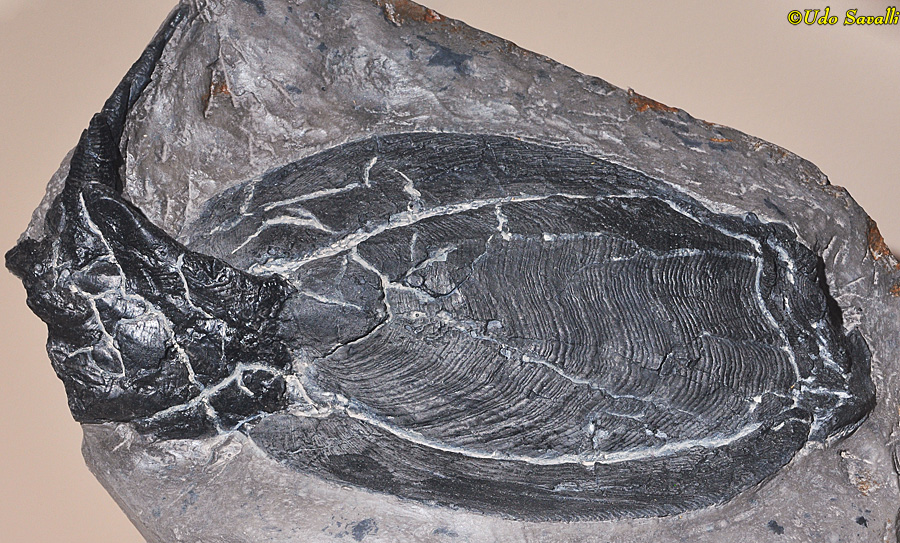
|
|
|
Cast of Drepanaspis gemuendenensis.
Germany
Early Devonian Period, 400 Ma
Wyoming Dinosaur Center
|
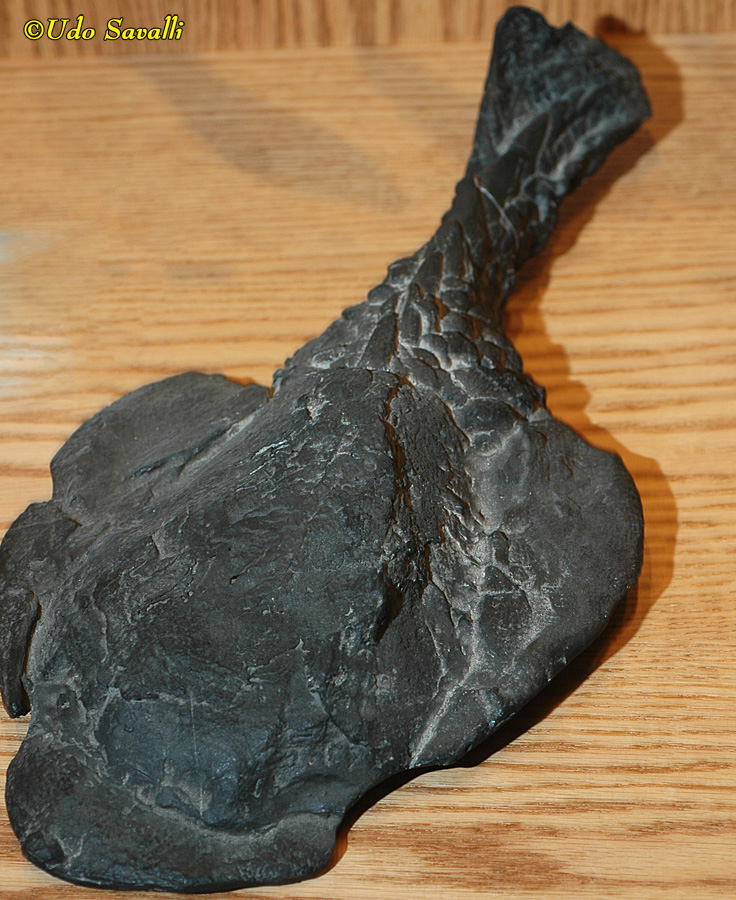
|
|
|
Life model of Jamoytius kerwoodi.
Taxonomy: Ostracodermi; Anaspsida
Silurian Period
Museum of Ancient Life, Utah
|
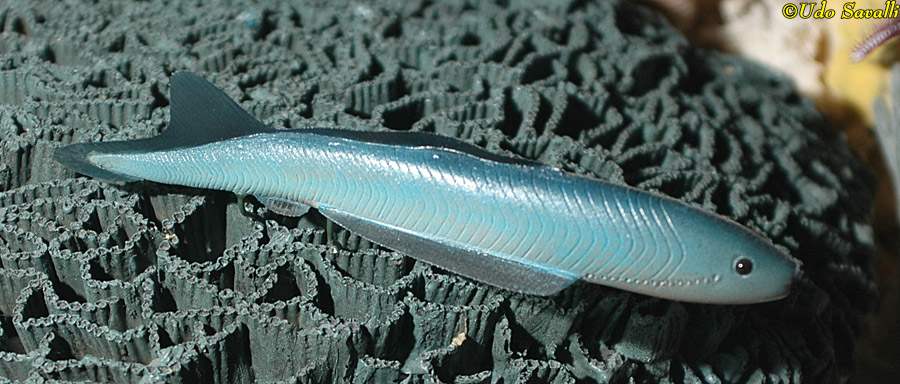
|
|
|
Life model of Drepanaspis gemuendenensis.
Taxonomy: Ostracodermi; Heterostraci; Pteraspidiformes
Early Devonian Period; Europe
Wyoming Dinosaur Center
|
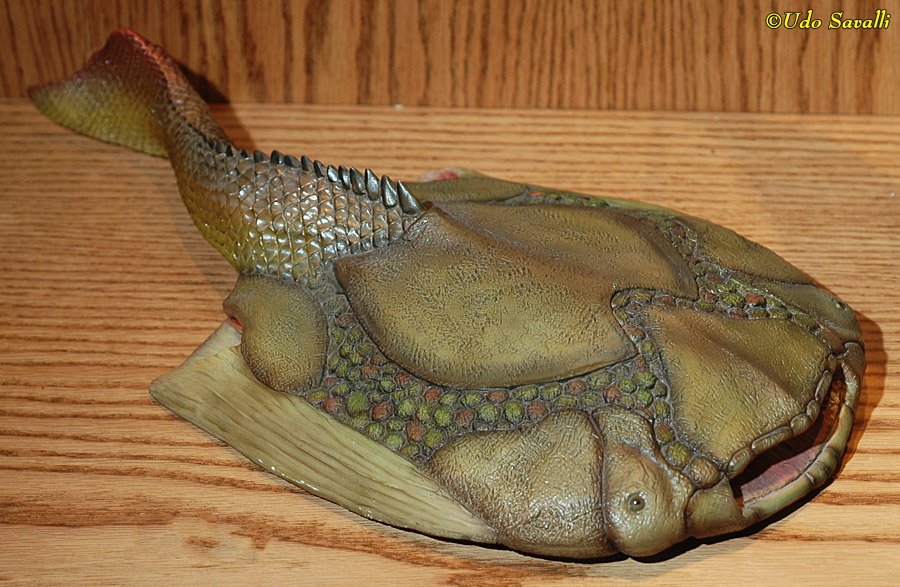
|
|
|
Life model of Protaspis transversa.
Taxonomy: Ostracodermi; Heterostraci; Pteraspidiformes
Early Devonian Period; Montana
Museum of Ancient Life, Utah
|

|
|
|
Life model of Cephalaspis powriei.
Taxonomy: Ostracodermi; Osteostraci; Antiarchi
Early Devonian Period, Scotland
Museum of Ancient Life, Utah
|
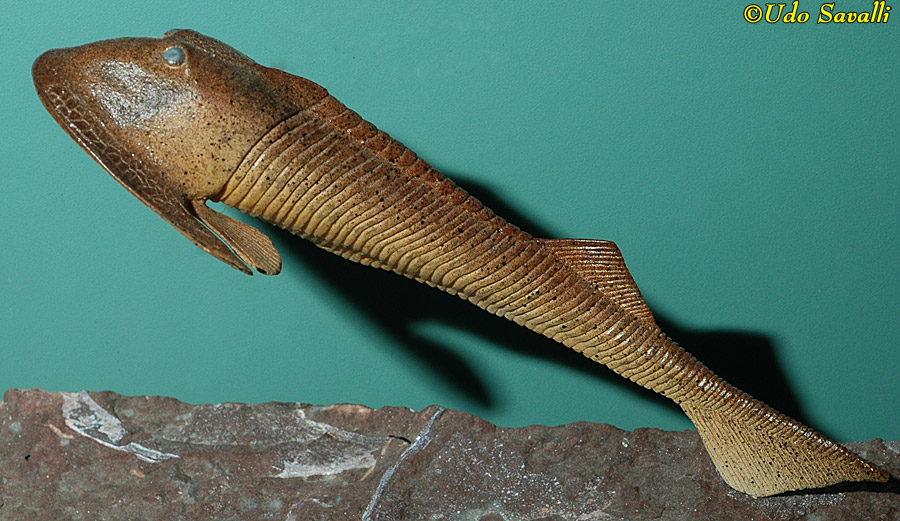
|
|
|
Life model of Pteraspis sp.
Taxonomy: Ostracodermi; Heterostraci; Pteraspidiformes
Early Devonian Period; Europe
Wyoming Dinosaur Center
|
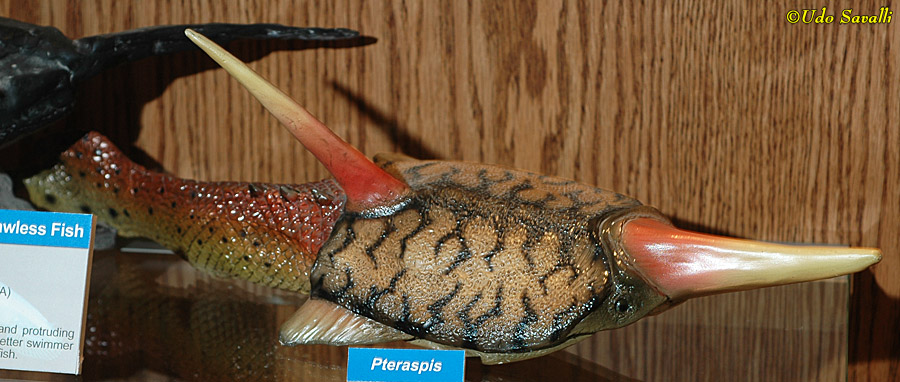
|
|
Placoderms — Armored Jawed Fishes
|
Pterichthyodes milleri. In addition to movable jaws, placoderms differed from their ostacoderm ancestors in having 2 sets of paired fins. Their armor was mostly restricted to the head and midbody.
Scotland
Early Devonian Period, 400 ma
MuseumInfo
|
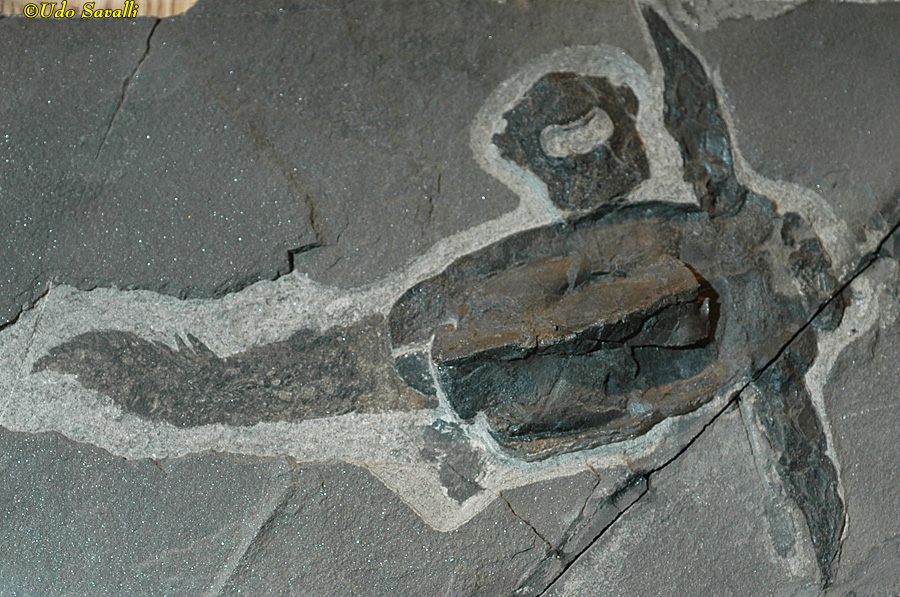
|
|
|
Coccosteus cuspidatus was a pelagic predator. Note the preservation of the internal skeleton (vertebral column and fin rays) in addition to the dermal armor.
Scotland
Middle Devonian Period, 385 Ma
Wyoming Dinosaur Center
|
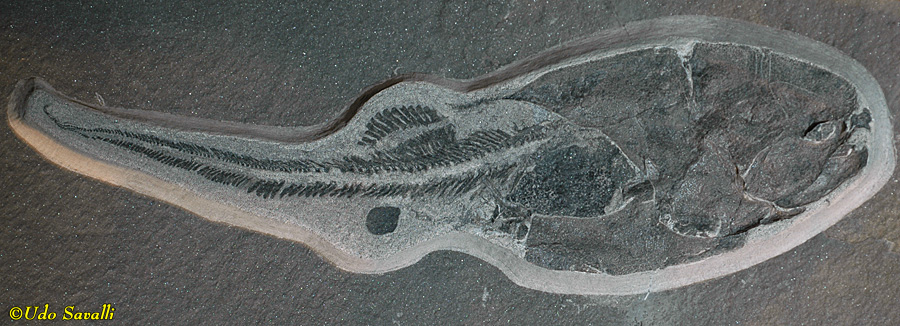
|
|
|
Bothriolepis canadensis was a benthic (bottom dwelling) feeder. The back half of the fish lacked armor and was thus not preserved.
Ontario, Canada
Late Devonian Period, 365 Ma
Black Hills Institute Museum, South Dakota
|
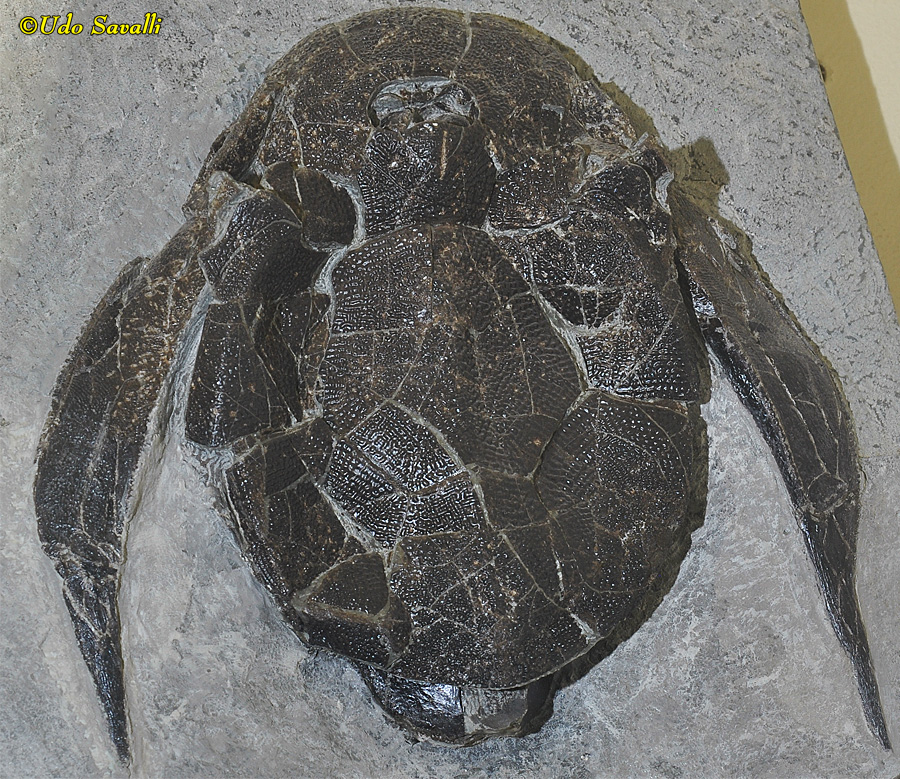
|
|
|
Dunkleosteus terrelli (cast of skull) was the largest predator on earth up to that time, reaching 8 m long. It lacked true teeth but had large, sharp bony plates lining its jaws.
Cuyahoga Co., OH
Middle Devonian Period
Denver Museum of Science & Nature
|
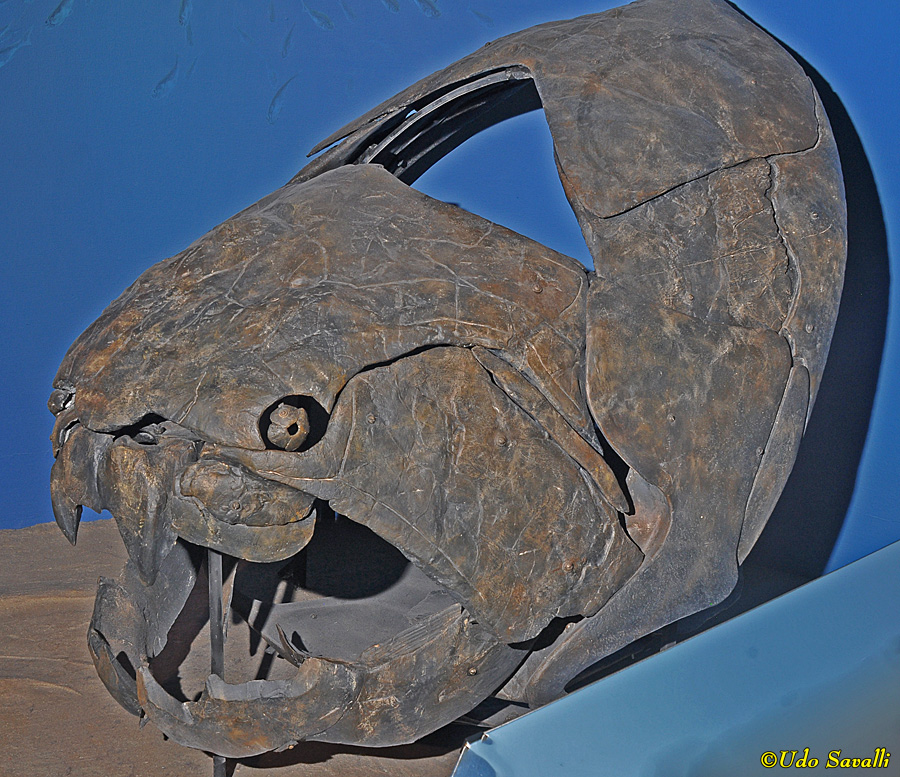
|
|
|
Life model of Coccosteus sp.
Taxonomy: Placodermi; Arthrodira
Middle-late Devonian Period
Wyoming Dinosaur Center
|
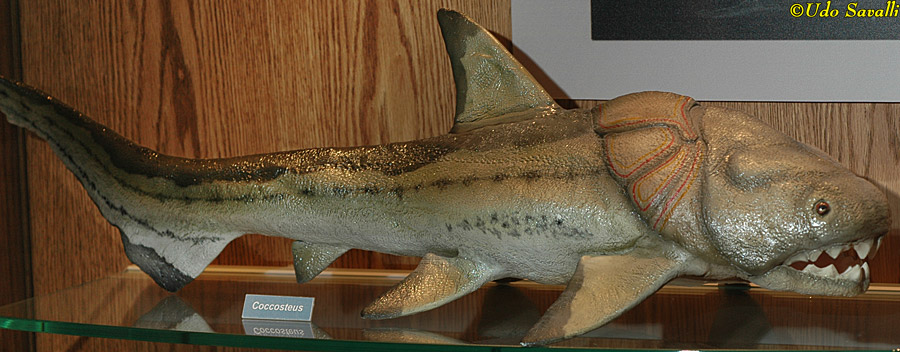
|
|
|
Life model of Gemuendina stuertzi.
Taxonomy: Placodermi; Rhenanida
Early Devonian Period; Europe
Wyoming Dinosaur Center
|
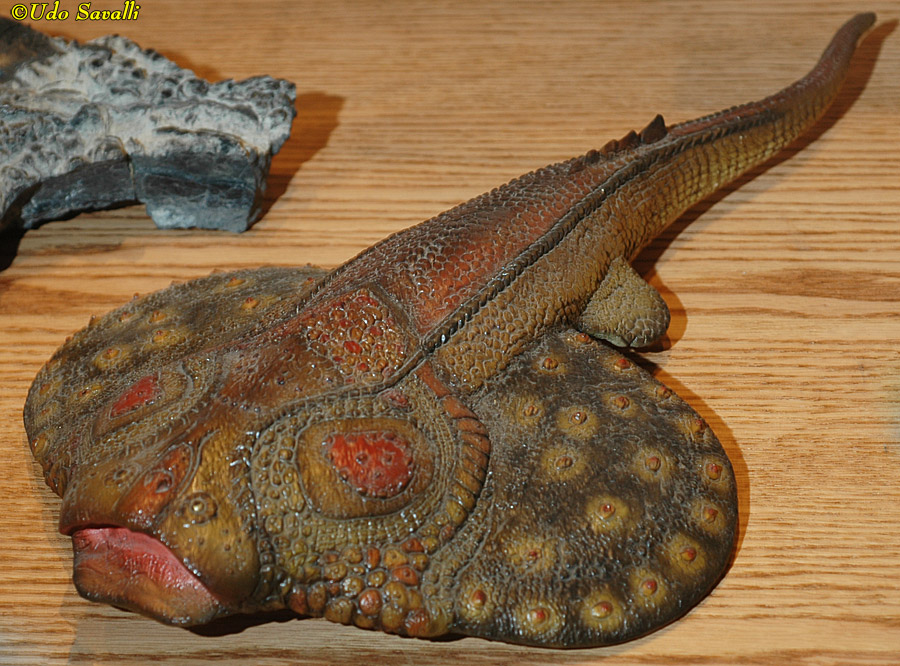
|
|
|
Life model of Pterichthyodes sp.
Taxonomy: Placodermi; Antiarchi
Devonian Period; Europe
Wyoming Dinosaur Center
|
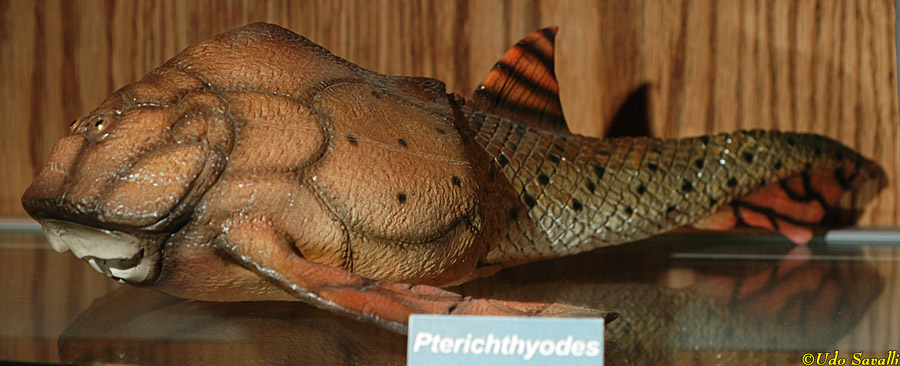
|
|
|
Life model of Bothriolepis sp.
Taxonomy: Placodermi; Antiarchi
Late Devonian Period
Wyoming Dinosaur Center
|
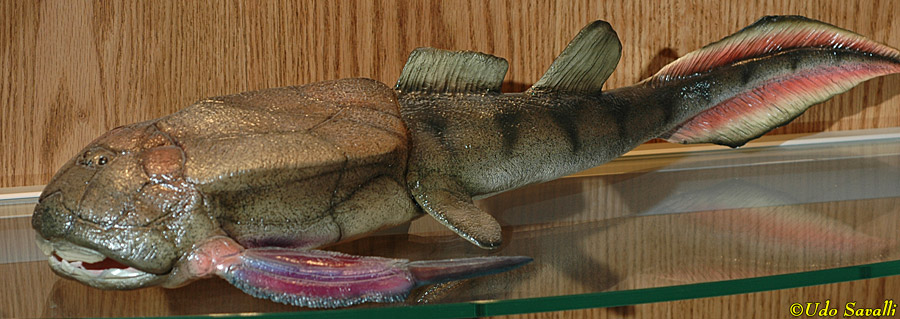
|
|
|
Life model of Bothriolepis sp.
Taxonomy: Placodermi; Antiarchi
Late Devonian Period
Museum of Ancient Life, Utah
|

|
|
|
Life model of Ctenurella sp. This species was viviparous (live-bearing).
Taxonomy: Placodermi; Ptyctodontida
Late Devonian Period; Germany
Museum of Ancient Life, Utah
|
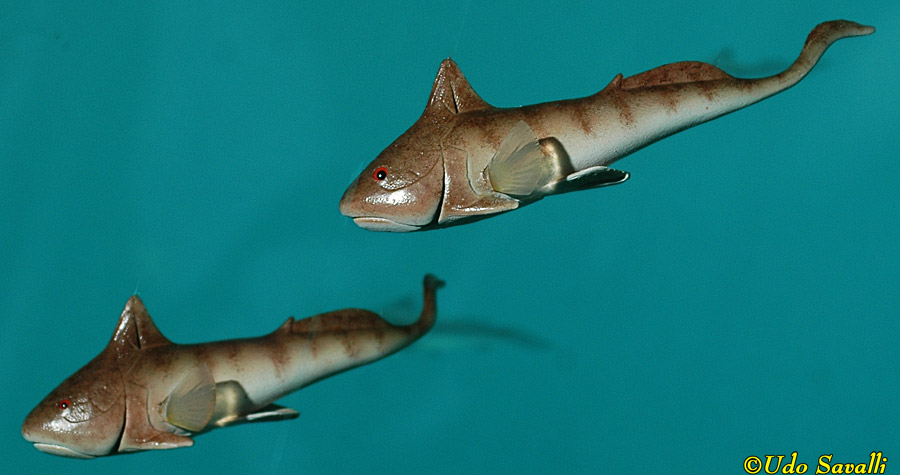
|
|
Acanthodians — Spiny Sharks
|
There has been a lot of debate about where the Acanthodians fit in the fish phylogeny, but recent studies suggest they are ancestors to the Chondrichthyes (cartilagenous fishes). They lacked bony armor plates but had large scales (which include layers of bone-like material) and spines on their fins. Their internal skeleton was cartilagenous, so fossils showing the entire animal, such as this one of Acanthodes bridgei, are rare.
Hamilton Quarry, Greenwood Co., KS
Carboniferous Period, Pennsylvanian Epoch
Black Hills Institute Museum, South Dakota
|
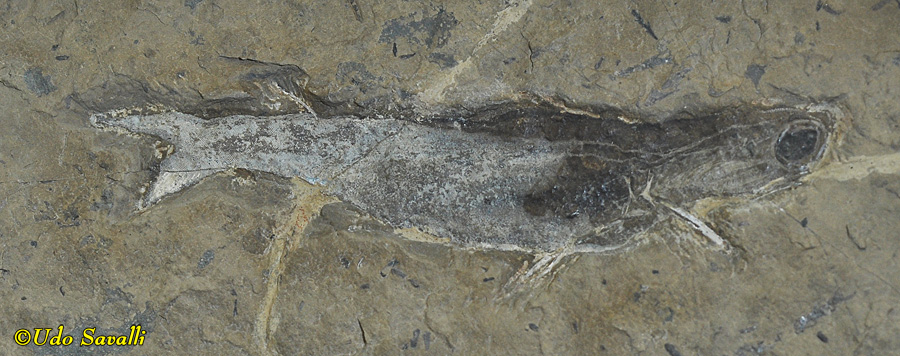
|
|
|
Life model of Acanthodes sp.
Taxonomy: Acanthodiformes
Carboniferous to Permian Periods, 409-284 Ma
Museum of Ancient Life, Utah
|
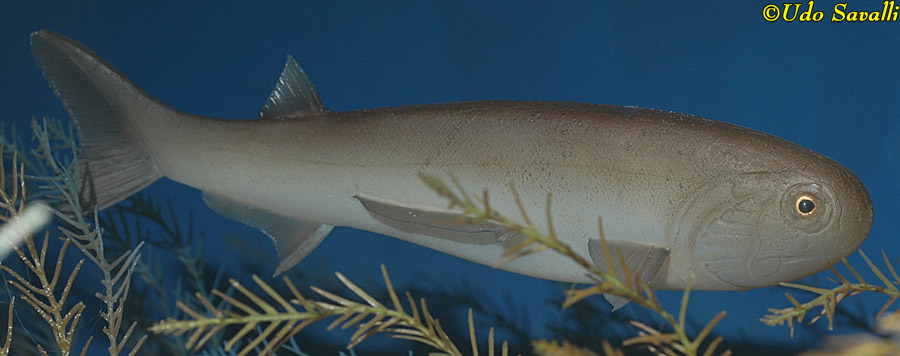
|
|
Chondrichthyes — Cartilagenous Fishes (Sharks, Rays, Etc.)
|
Chondrichthyes means "cartilage fish" and reflects their cartilagenous skeleton (jaws can become mineralized but this is not true bone). Unlike more primitive fish, they lack the bony dermal armor plates, so except for their teeth, they rarely fossilize except under rare conditions. This fossil is Xenacanthus sp., a very primitive shark with a prominent dorsal spine.
Germany
Early Permian Period
Wyoming Dinosaur Center
|
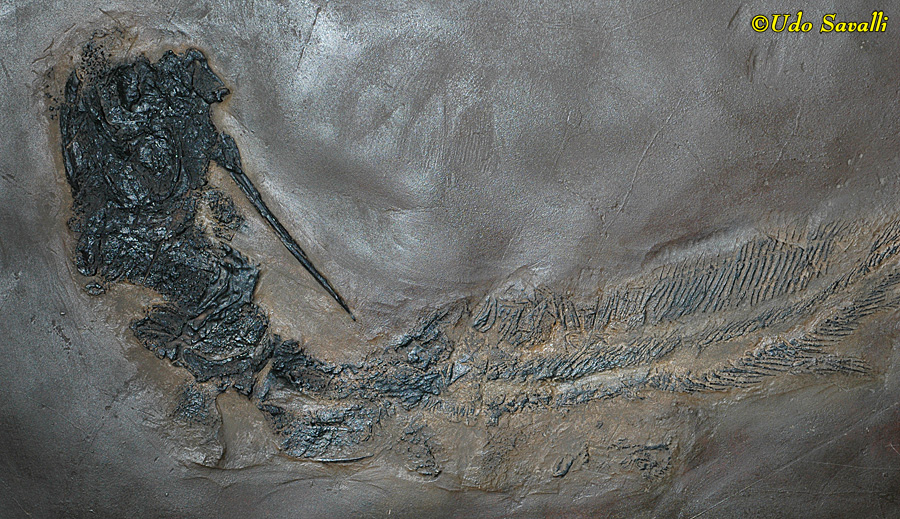
|
|
|
Echinochimera melton is a distant cousin to the deep-sea chimaeras or ratfishes, an offshoot of the Chondrichthyes that is outside of the group that includes the familiar true sharks and rays.
Central Montana
Carboniferous Period, Mississippian Epoch, Bear Gulch Limestone, 320 Ma
Museum of the Rockies, Montana
|
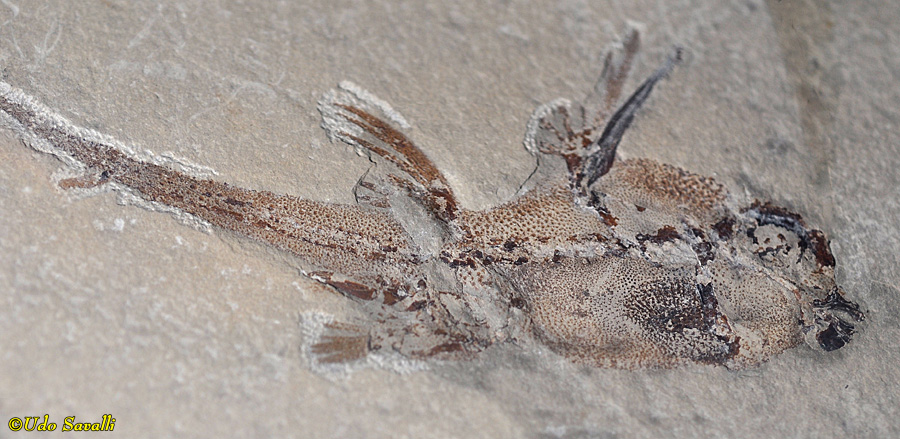
|
|
|
Falcatus falcatus is a strange, primitive shark; the male's dorsal fin forms a forward-pointing prong that is hooked through the female's jaw during mating.
Fergus Co., Montana
Carboniferous Period, Mississippian Epoch, Bear Gulch Limestone, 320 Ma
Black Hills Institute Museum, South Dakota
|

|
|
|
Cat shark, Scyliorhinus sp. This genus persists to this day.
Lebanon
Late Cretaceous Period, Cenomanian Stage
Black Hills Institute Museum, South Dakota
|

|
|
|
Micropristis solomonis sawfish had an elongated rostrum (snout) lined with tiny teeth that were used to hunt small fish.
Hadjula, Lebanon
Late Cretaceous Period, Cenomanian Stage
Black Hills Institute Museum, South Dakota
|
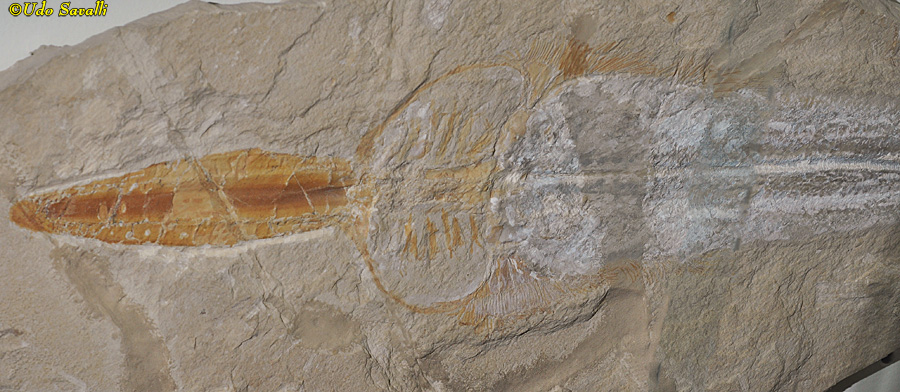
|
|
|
A guitarfish (a kind of ray), Rhinobatus sp., virtually unchanged from moderns species belonging to the same genus.
Solnhofen Limestone, Germany
Late Jurassic Period, 150 Ma
Wyoming Dinosaur Center
|
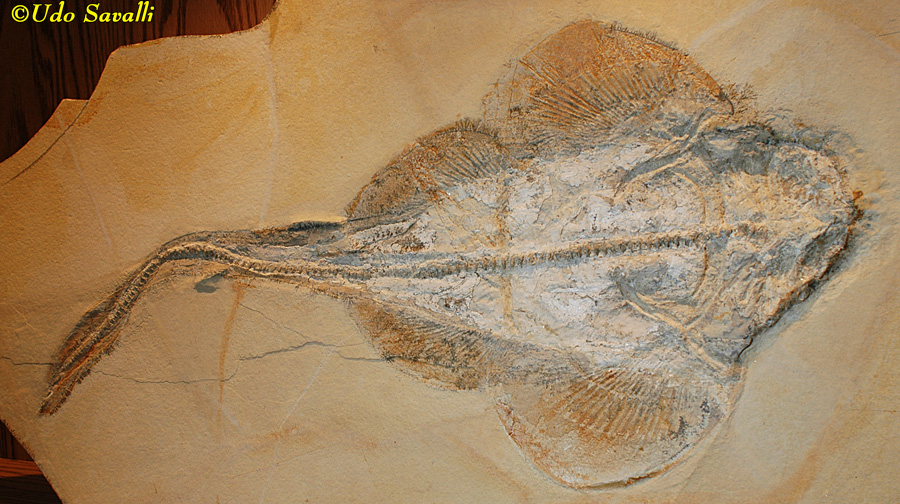
|
|
|
Pararaja expansa ray.
Lebanon
Late Cretaceous Period, Cenomanian Stage
Black Hills Institute Museum, South Dakota
|
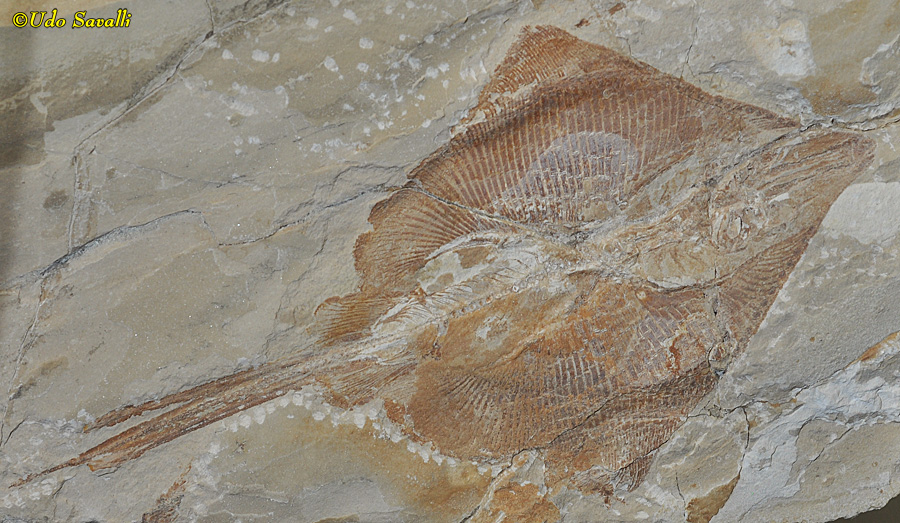
|
|
|
The sting-ray-like skate Cyclobatis major.
Lebanon
Late Cretaceous Period, Cenomanian Stage, 98 Ma
Museum of Ancient Life, Utah
|
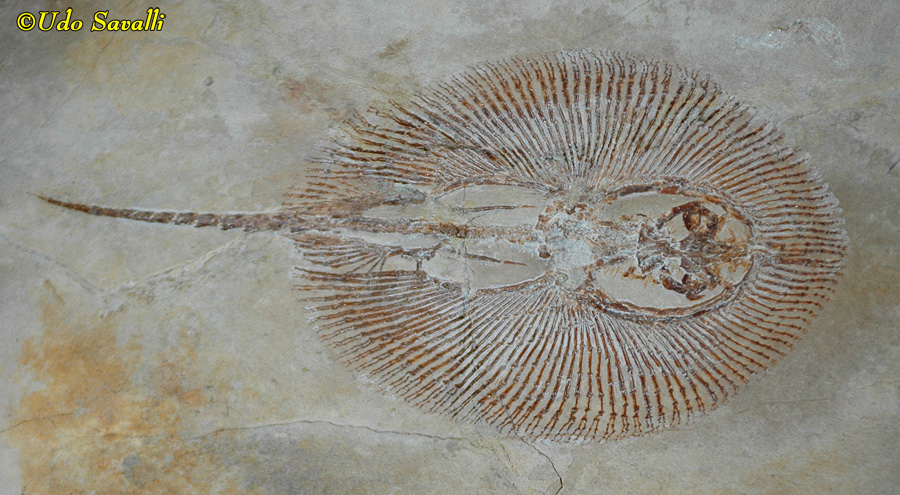
|
|
|
A sting-ray, Heliobatis radians.
Wyoming
Early Eocene Epoch, Green River Formation, 50 Ma
Wyoming Dinosaur Center
|
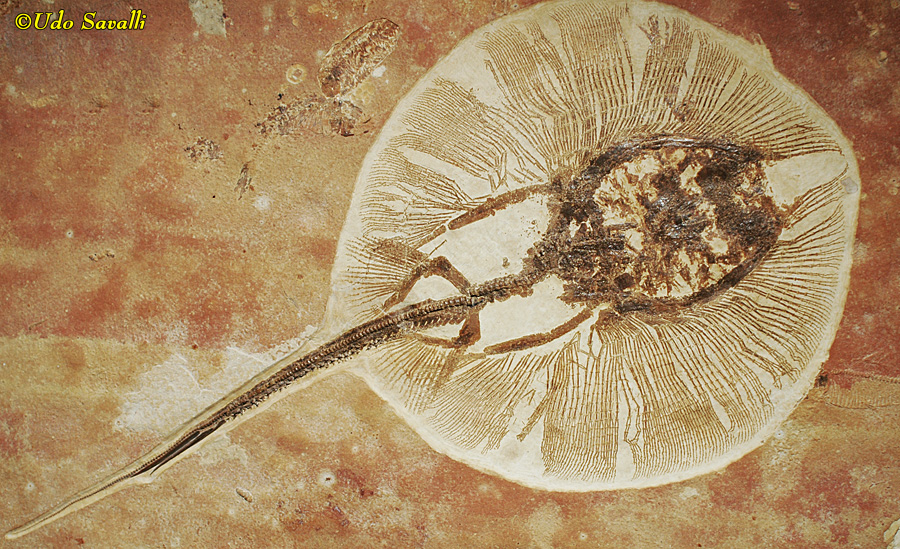
|
|
|
Life models of Belantsea montana and two bradydont sharks.
Taxonomy: Chondrichthyes; Holocephali; Petalodontiformes
Carboniferous Period
Arizona Museum of Natural History
|
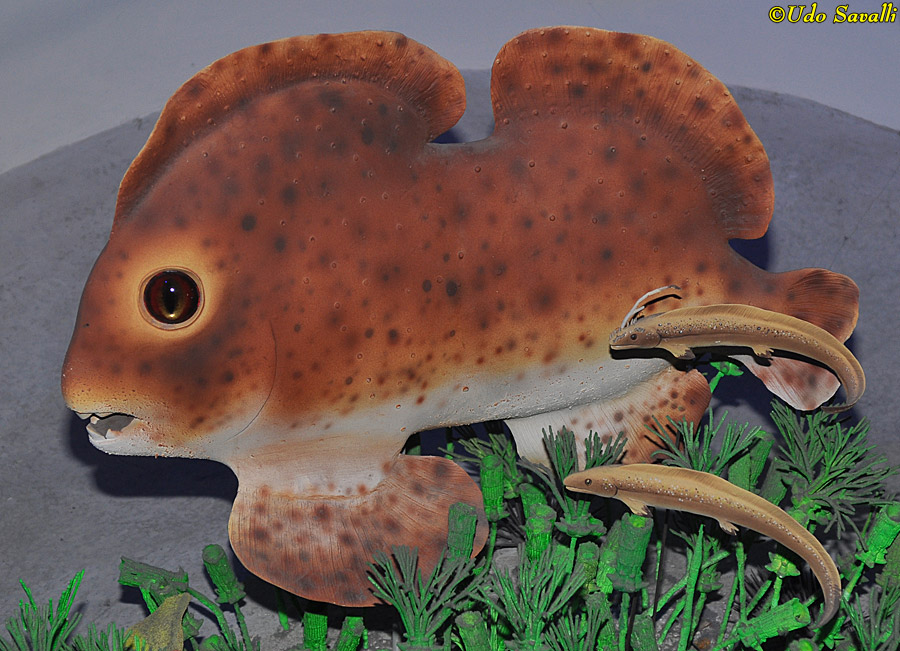
|
|
|
Life model of Falcatus facatus (the unicorn shark). This is a male; females lack the spine-like dorsal fin.
Taxonomy: Chondrichthyes; Holocephali; Symmoriida
Carboniferous Period, Late Mississippian Epoch, 320 Ma; Montana
Museum of the Rockies, Montana
|
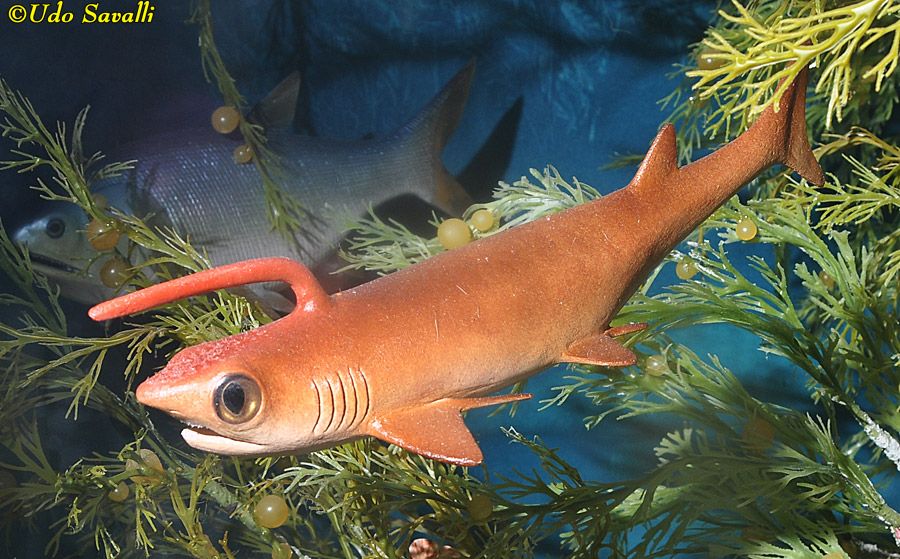
|
|
|
Life models of Echinochimera meltoni male and two smaller females.
Taxonomy: Chondrichthyes; Holocephali; Chimaeriformes
Carboniferous Period, Late Mississippian Epoch, 320 Ma; Montana
Museum of the Rockies, Montana
|
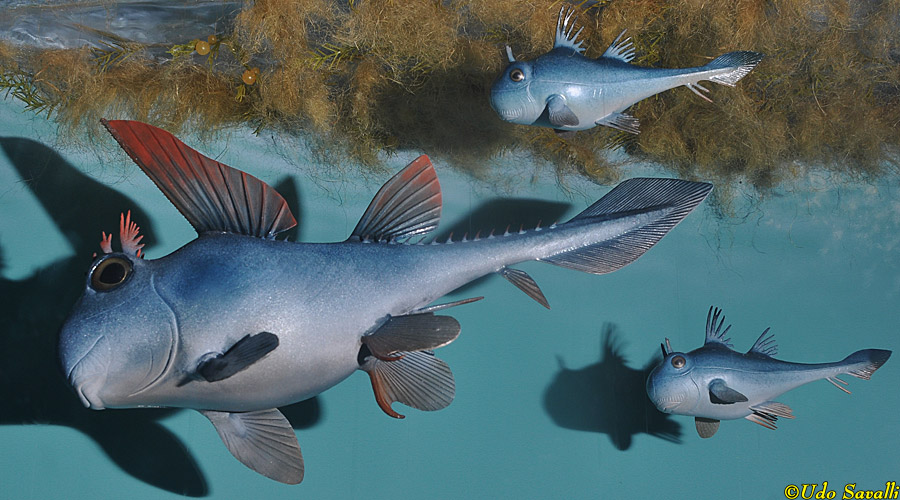
|
|
|
Life model of Cladoselache sp.
Taxonomy: Chondrichthyes; Holocephali; Cladoselachiformes
Late Devonian Period
Museum of Ancient Life, Utah
|
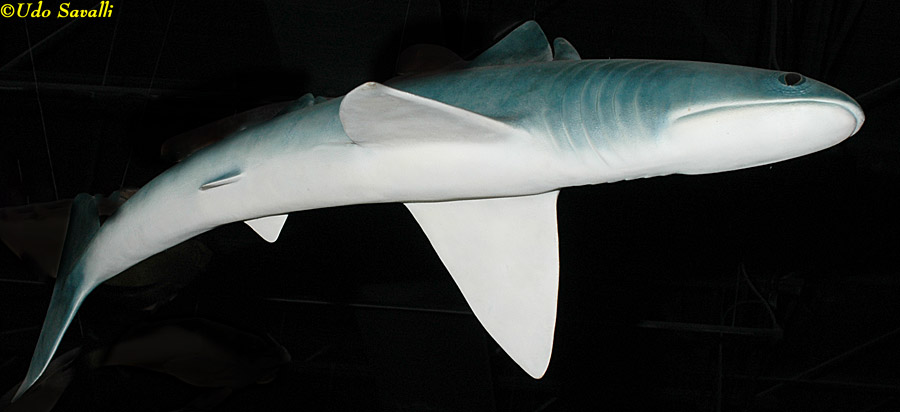
|
|
|
Life model of Symmorium sp. (may be a female Stethacanthus).
Taxonomy: Chondrichthyes;
Carboniferous Period, Pennsylvanian Epoch
Arizona Museum of Natural History
|
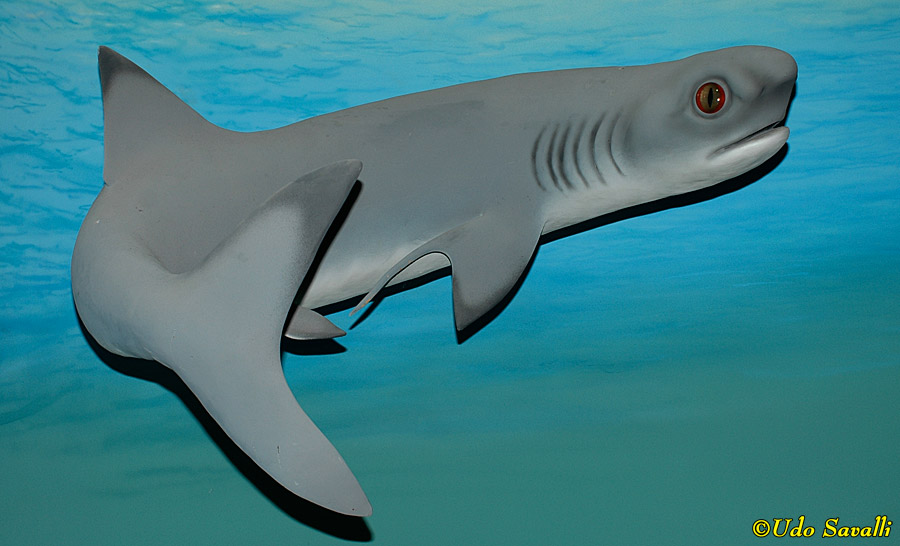
|
|
|
Life models of Stethacanthus, the "ironing board shark." The female is in the foreground and the male, with his distinctive dorsal fin, is in the back.
Taxonomy: Chondrichthyes;
Carboniferous Period, Pennsylvanian Epoch, 320 Ma; Montana
Wyoming Dinosaur Center
|
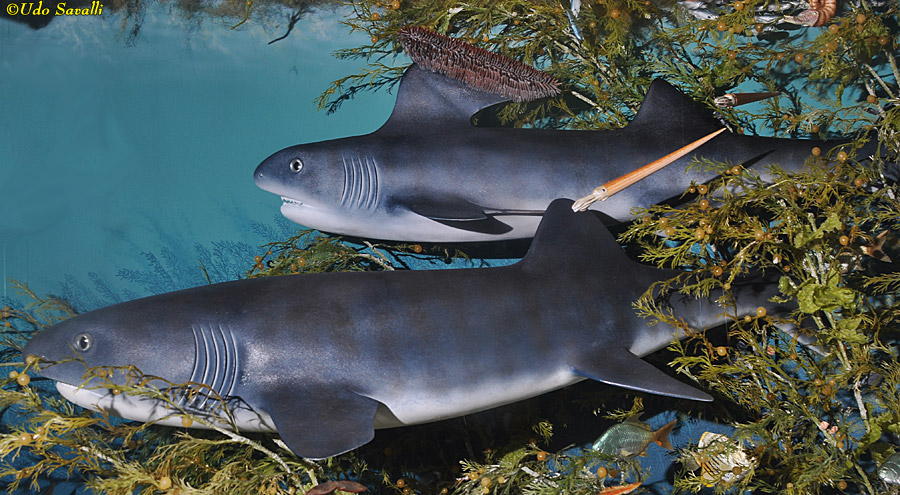
|
|
Sarcopterygii — Lobe-finned Fishes (Coelacanths & Lungfish)
|
The bony fishes have an internal skeleton of bone rather than cartilage. They have scales and mostly lack armor, although most of their skull bones are derived from the armor head plates of their ancestors.
There are two subdivisions of the bony fishes: the Sarcopterygiii, or lobe-finned fishes, in which the paired fins are supported by a column of bone, and the Actinopterygii (below), in which the fins are supported by more delicate fin rays.
The 6 living species of sarcopterygian fishes are the coelacanths and lungfishes. Most coelacanths can be easily recognized by their symmetric three-lobed tail, such as in this Coccoderma nudum
Solnhofen Limestone, Germany
Late Jurassic Period, 150 Ma
Wyoming Dinosaur Center
|
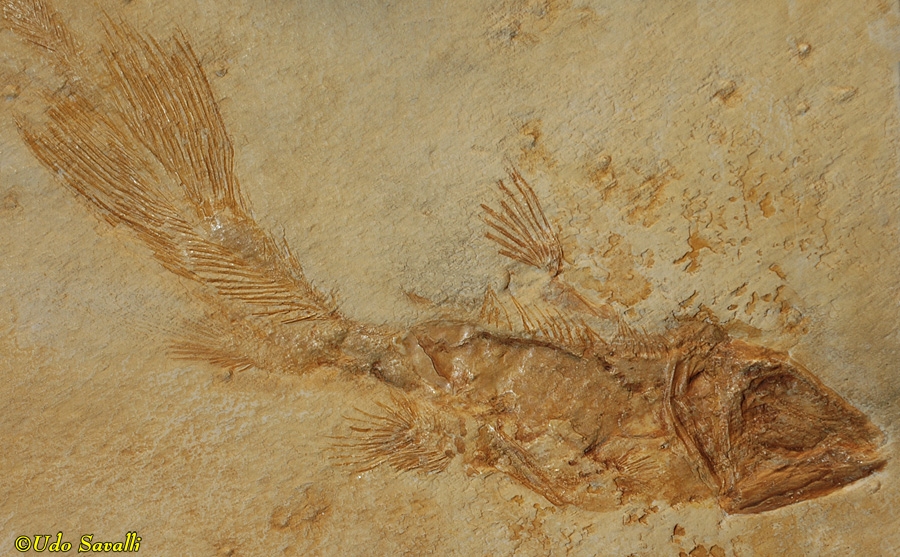
|
|
|
This Caridosuctor populosum is an example of an extinct coelacanth. The two modern species are examples of "Lazarus species," organisms known from the fossil record before any living examples were discovered (the first in 1938).
Central Montana
Carboniferous Period, Mississippian Epoch, Bear Gulch Limestone, 320 Ma
Museum of the Rockies, Montana
|
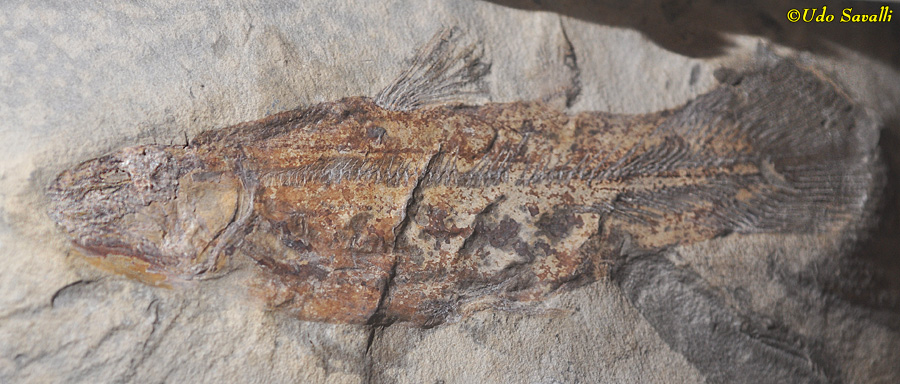
|
|
|
This fossil cast is of the primitive coelacanth fish Axelrodichthys araripensis
Brazil
Early Cretaceous Period, 110 Ma
Wyoming Dinosaur Center
|

|
|
|
Although there are only two living species of coelacanths, their fossil record is much more diverse, with some such as this Allenypterus montanus having atypical body shapes.
Central Montana
Carboniferous Period, Mississippian Epoch, Bear Gulch Limestone, 320 Ma
Museum of the Rockies, Montana
|
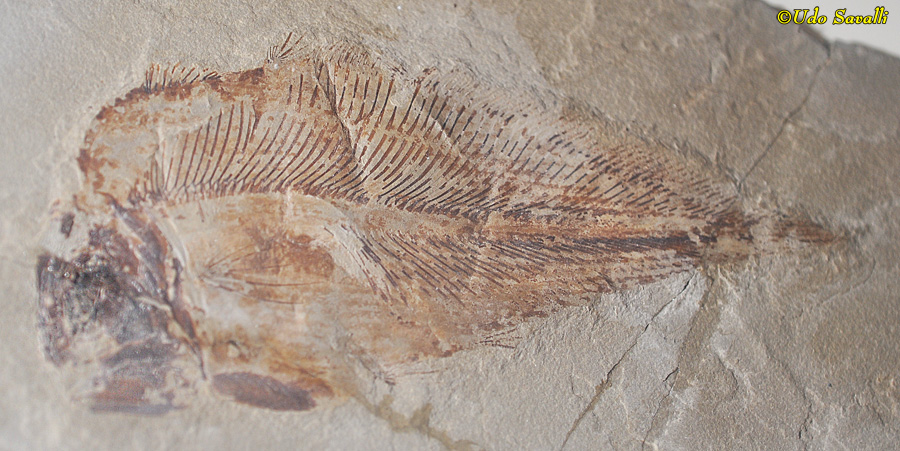
|
|
|
Life model of Cardiosuctor populosum, a coelacanth.
Taxonomy: Sarcopterygii;
Carboniferous Period, Late Mississippian Epoch, 320 Ma; Montana
Museum of Ancient Life, Utah
|
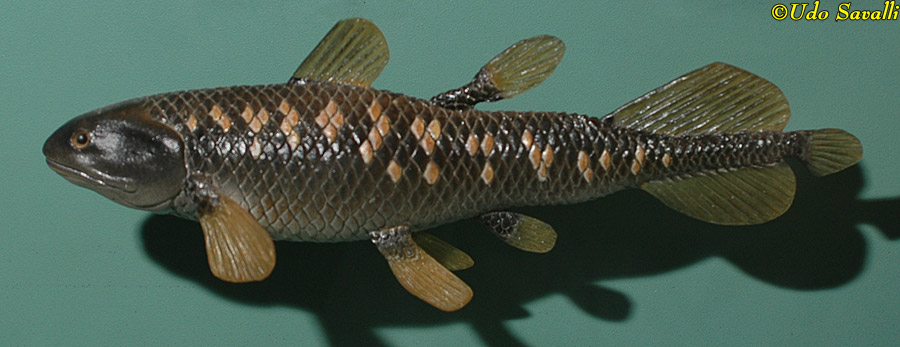
|
|
|
There are 4 species of extant lungfishes, living in tropical swamps and rivers, but fossil species were much more diverse. This is a cast of Uranolophus wyomingensis.
Denver Museum of Science & Nature
|
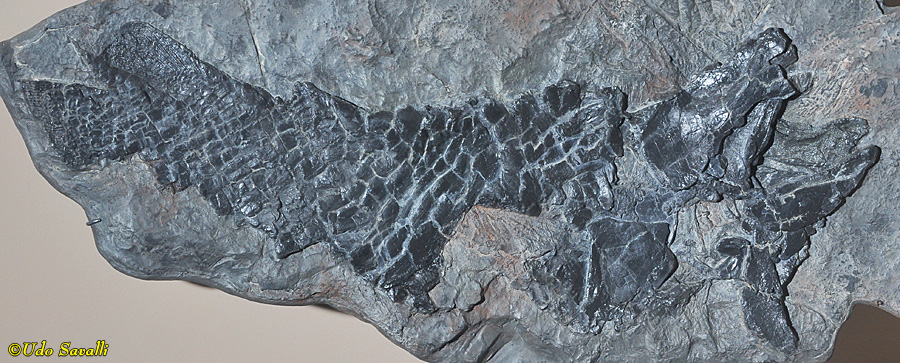
|
|
|
Pentlandia macroptera lungfish.
Old Red Sandstone, Caithness, Scotland
Middle Devonian Period
Black Hills Institute Museum, South Dakota
|
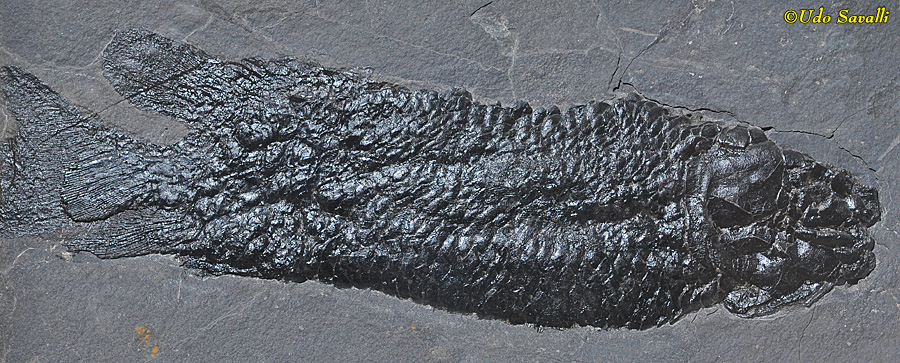
|
|
|
Life model of Ceratodus sp. lungfish.
Taxonomy: Sarcopterygii; Ceratodontiformes
Triassic Period
Arizona Museum of Natural History
|
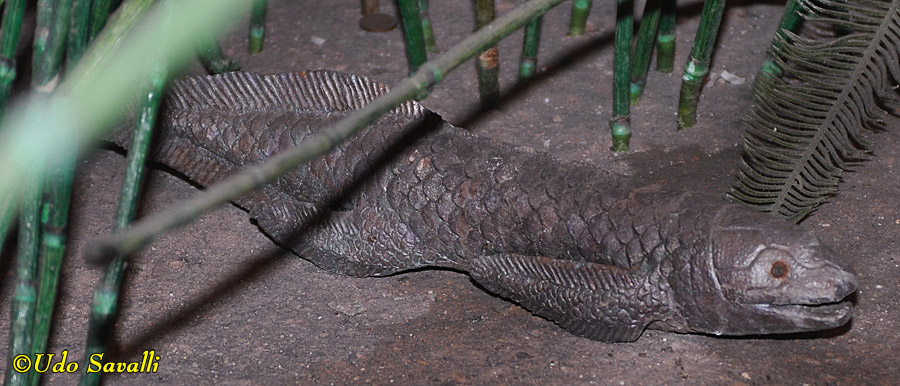
|
|
|
Life model of Uranolophus wyomingensis lungfish.
Taxonomy: Sarcopterygii; Uranolophina
Late Devonian Period
Museum of Ancient Life, Utah
|
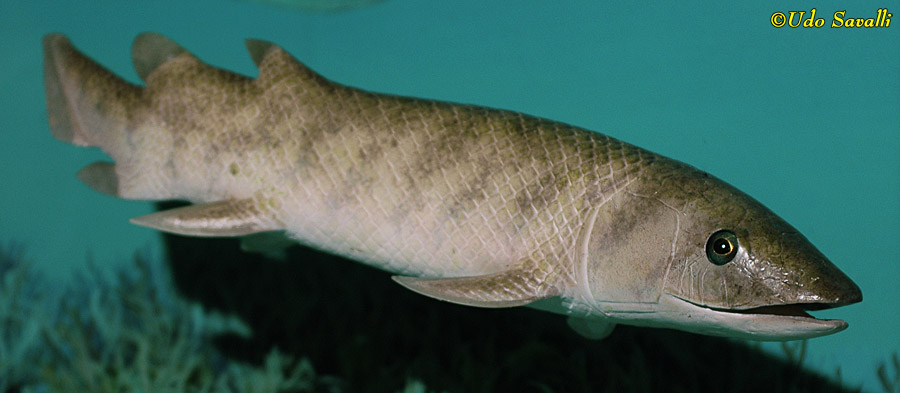
|
|
|
The Osteolepiformes, such as this Gyroptychius agassizi, are an extinct group of sarcopterygian (lobe-finned) fishes that are the sister-group to the tetrapods (animals with four legs).
Orkney, Scotland
Devonian Period
Black Hills Institute Museum, South Dakota
|
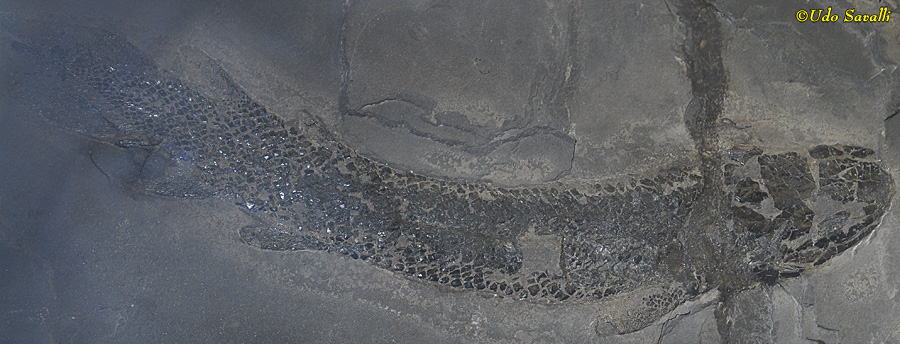
|
|
|
Eusthenopteron foordi is one of the best-known of the osteolepiformes with over 2000 specimens. It was also one of the largest, reaching up to 1.8 m in length.
Escuminac Formation, Quebec
Late Devonian Period, 365 Ma
Denver Museum of Science & Nature
|

|
|
|
Life models of Osteolepis macrolepidotus.
Taxonomy: Sarcopterygii; Osteolepiformes
Middle Devonian Period; Scotland
Museum of Ancient Life, Utah
|
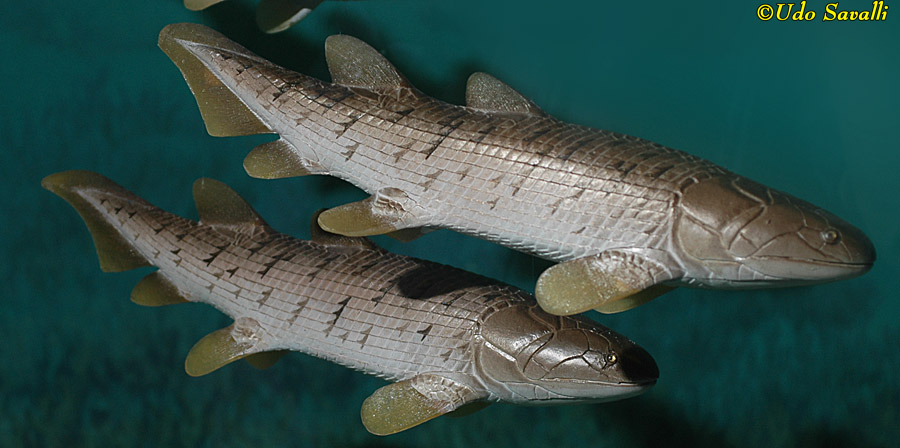
|
|
|
Life model of Eusthenopteron sp., a large lobe-finned fish related to the tetrapods.
Taxonomy: Sarcopterygii; Tetrapodamorpha
Late Devonian Period; North America
Wyoming Dinosaur Center
|
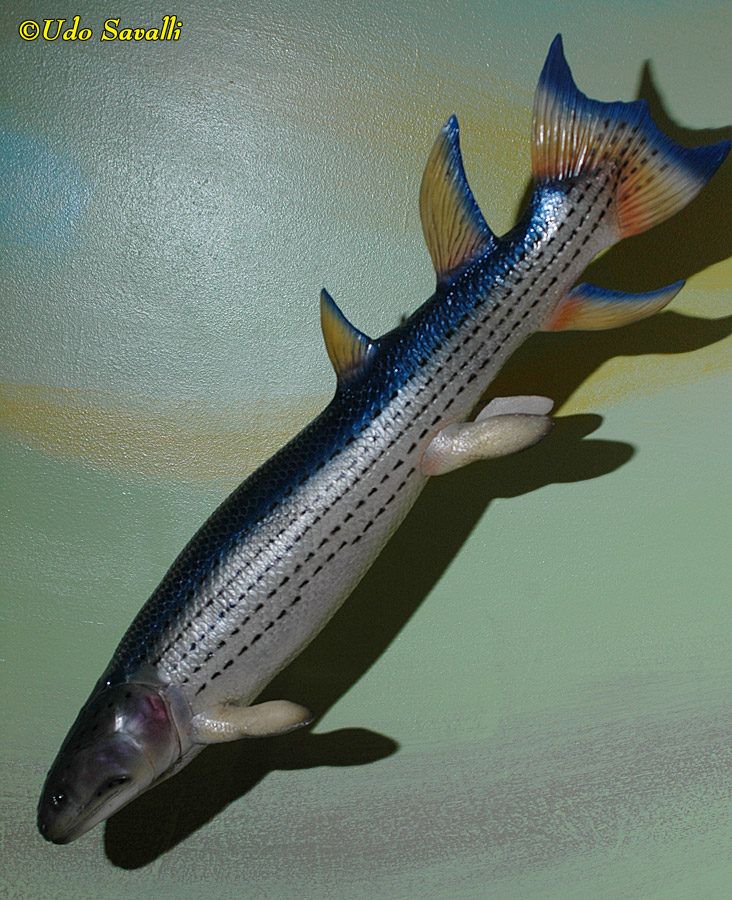
|
|
|
Life model of Panderichthys rhombolepis. This species probably lived in shallow water and may have hunted near the surface, as suggested by its flat skull and lack of dorsal fin. It is closely related to the tetrapods.
Taxonomy: Sarcopterygii; Tetrapodamorpha
Middle Devonian Period, 3970 Ma; Latvia
Museum of Ancient Life, Utah
|

|
|
|
Life model of Tiktaalik roseae. The "fishapod" has characteristics intermediate between lobe-finned fishes (such as Panderichthys) and the tetrapods (amphibians), including gills, fin rays, the presence of a neck and wrists.
Taxonomy: Sarcopterygii; Tetrapodamorpha; Elpistostegalia
Late Devonian Period, 375 Ma; Canada
Wyoming Dinosaur Center
|
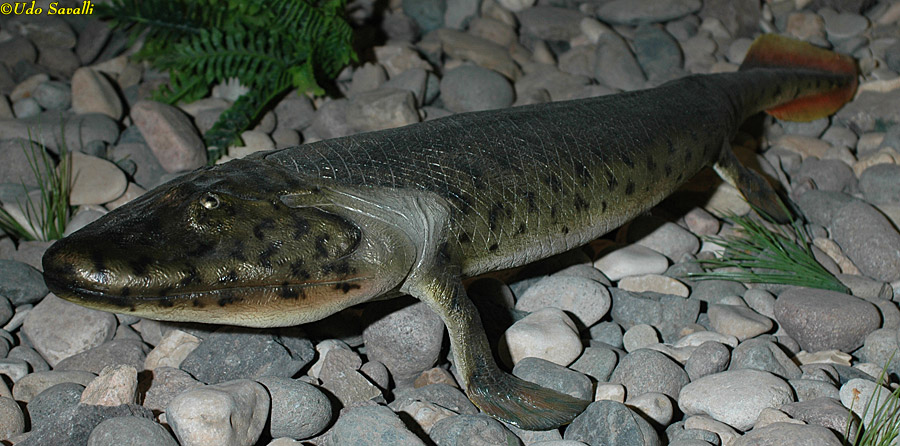
|
|
|
















































